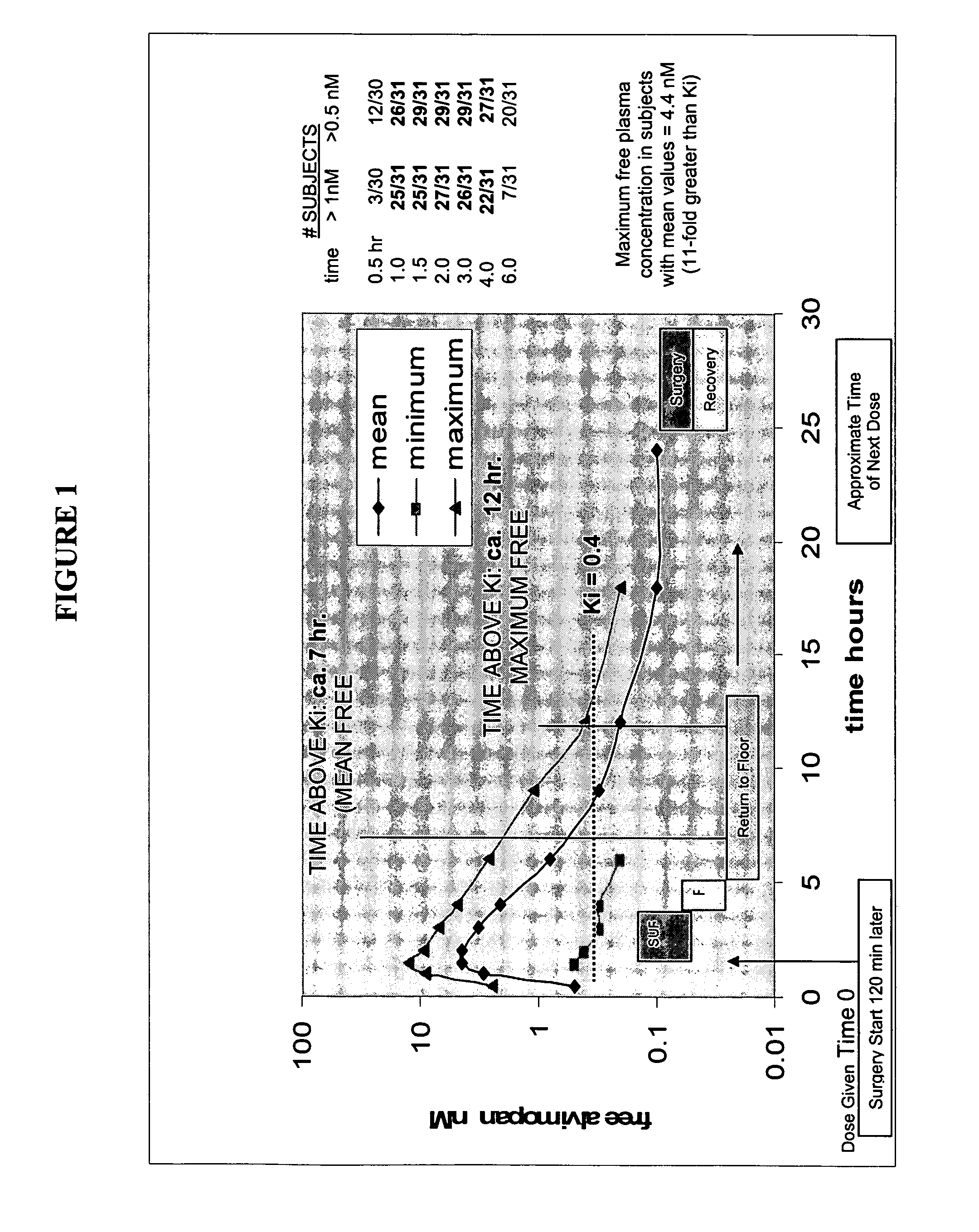Methods of preventing and treating gastrointestinal dysfunction
a gastrointestinal and gastrointestinal disease technology, applied in the field of preventing and treating gastrointestinal (gi) dysfunction, can solve the problems of intestinal dysfunction, side effects, mu opioid agonists, etc., and achieve the effect of preventing gastrointestinal dysfunction
- Summary
- Abstract
- Description
- Claims
- Application Information
AI Technical Summary
Benefits of technology
Problems solved by technology
Method used
Image
Examples
example 1
[0485]Twelve milligrams of alvimopan (two 6 mg capsules) was administered orally to patients about 120 minutes prior to surgery. The free alvimopan plasma concentration was measured for about 24 hours. The results are shown in FIG. 1.
[0486]FIG. 1 shows the free plasma concentration of alvimopan (12 mg dose) (in nM) as a function of time (in hours). This figure shows that a single 12 mg oral dose of alvimopan produced free plasma concentrations sufficient to substantially saturate μ opioid receptors in the GI tract. Maximum concentrations achieved were 11-fold greater than the Ki. Moreover, the profile demonstrates that the Ki is exceeded at various times by a factor ranging from approximately 6 to twice the Ki; concentrations that would be estimated to produce receptor occupancy of greater than 68%, still within a reasonable interpretation of “substantial saturation.”
example 2
[0487]A randomized, double-blind, placebo-controlled study of different doses of alvimopan (opioid antagonist) I.V. for 4 days in the presence and absence of loperamide (opioid) 2 mg p.o. q.i.d. in 60 healthy subjects (n=12 in each of five treatment groups) was carried out. Subjects were randomly assigned to receive one of the following five treatments:[0488]Group 1: Placebo for alvimopan I.V. b.i.d.+placebo for loperamide p.o. q.i.d. (n=12)[0489]Group 2: Placebo for alvimopan I.V. b.i.d.+loperamide 2 mg p.o. q.i.d. (n=12)[0490]Group 3: Alvimopan 1 mg I.V. b.i.d.+loperamide 2 mg p.o. q.i.d. (n=12)[0491]Group 4: Alvimopan 0.45 mg I.V. b.i.d.+loperamide 2 mg p.o. q.i.d. (n=12)[0492]Group 5: Alvimopan 0.1 mg I.V. b.i.d.+loperamide 2 mg p.o. q.i.d. (n=12)
Oral SITZMARKS capsules containing radio-opaque markers were be administered on Days 1, 2, and 3. Alvimopan and loperamide was administered at the same time, when applicable.
Study Assessments
[0493]Serial blood samples were collected for...
PUM
| Property | Measurement | Unit |
|---|---|---|
| time | aaaaa | aaaaa |
| total volume | aaaaa | aaaaa |
| birthing stress | aaaaa | aaaaa |
Abstract
Description
Claims
Application Information
 Login to View More
Login to View More - R&D
- Intellectual Property
- Life Sciences
- Materials
- Tech Scout
- Unparalleled Data Quality
- Higher Quality Content
- 60% Fewer Hallucinations
Browse by: Latest US Patents, China's latest patents, Technical Efficacy Thesaurus, Application Domain, Technology Topic, Popular Technical Reports.
© 2025 PatSnap. All rights reserved.Legal|Privacy policy|Modern Slavery Act Transparency Statement|Sitemap|About US| Contact US: help@patsnap.com



